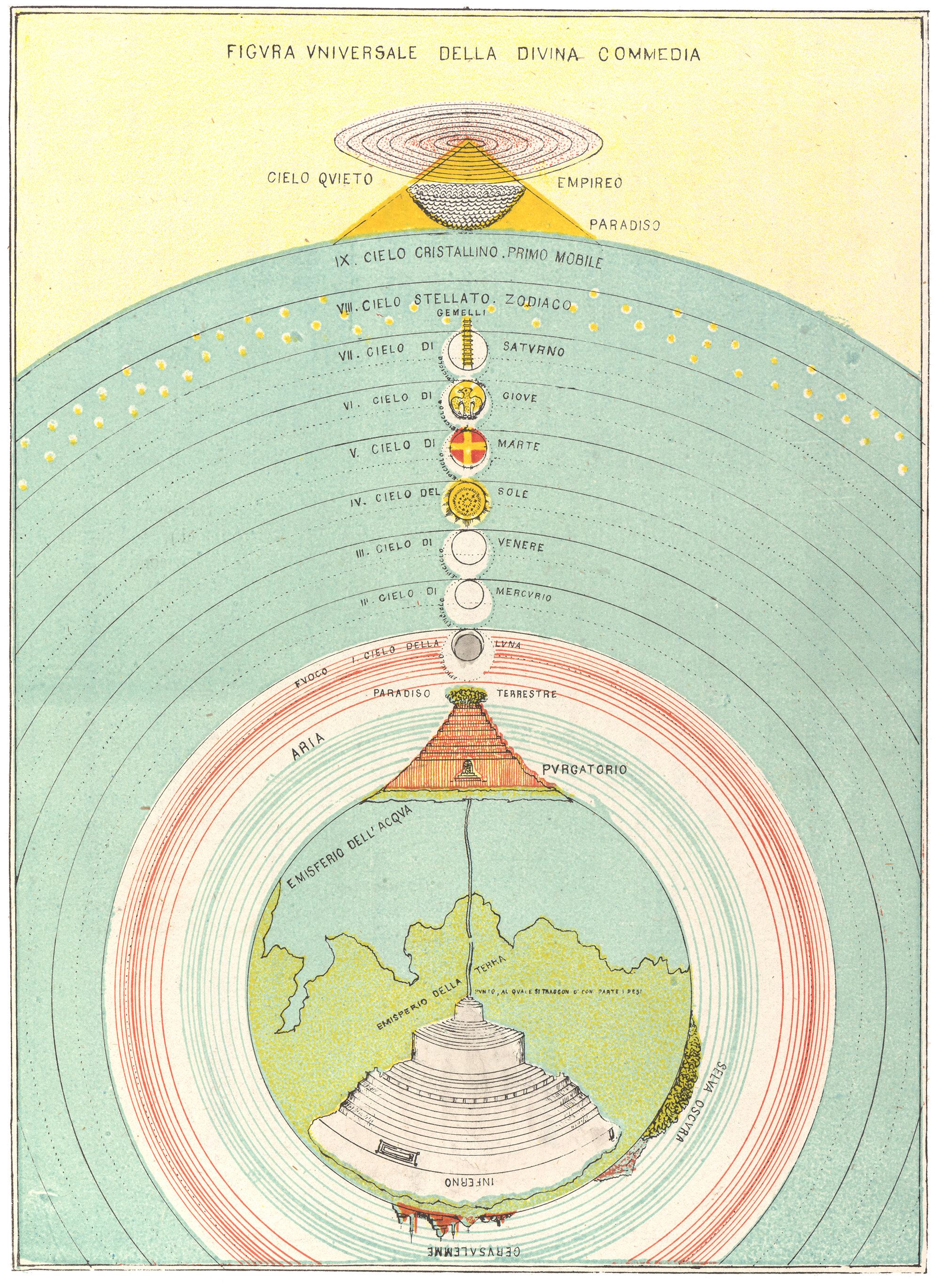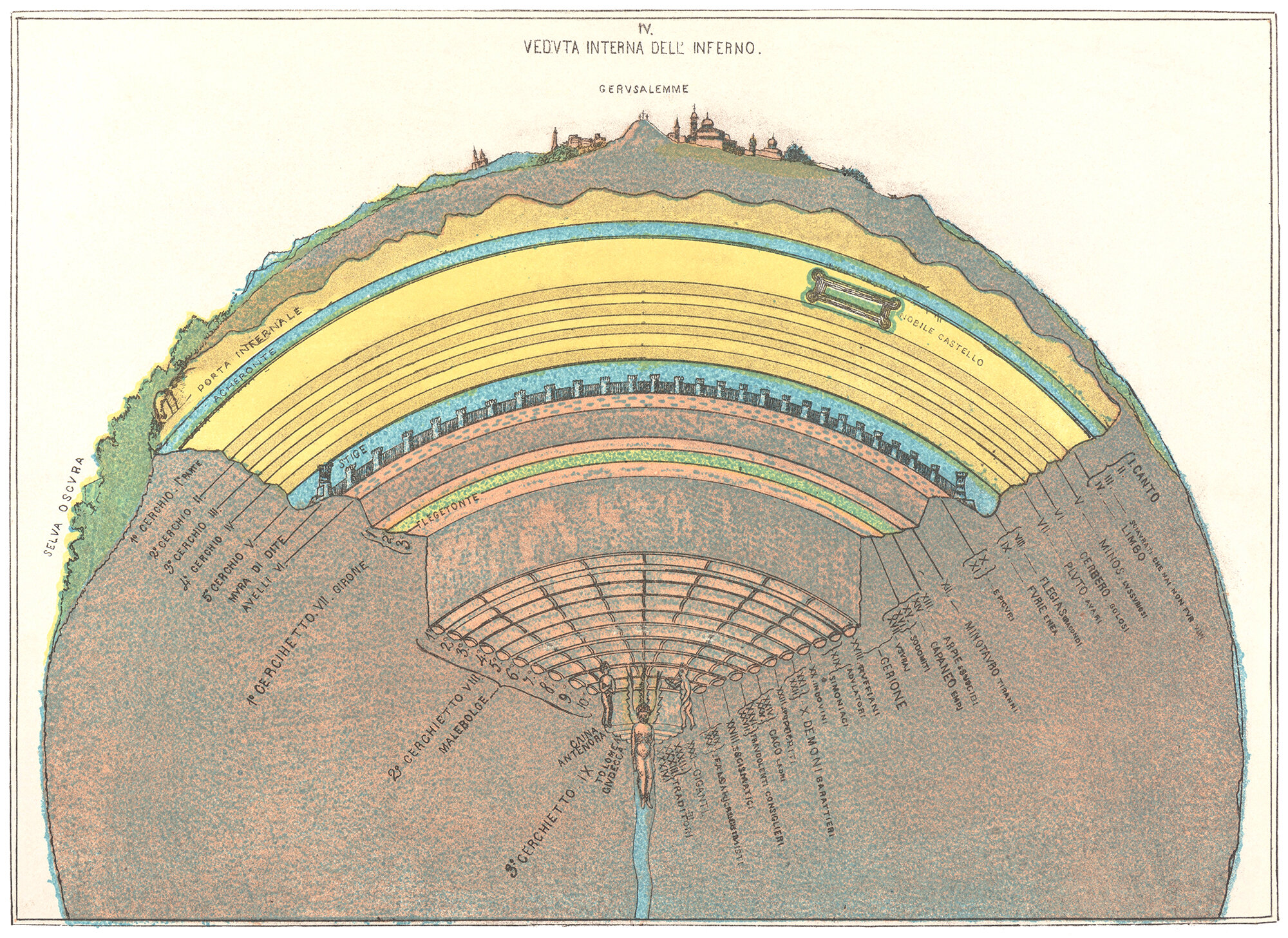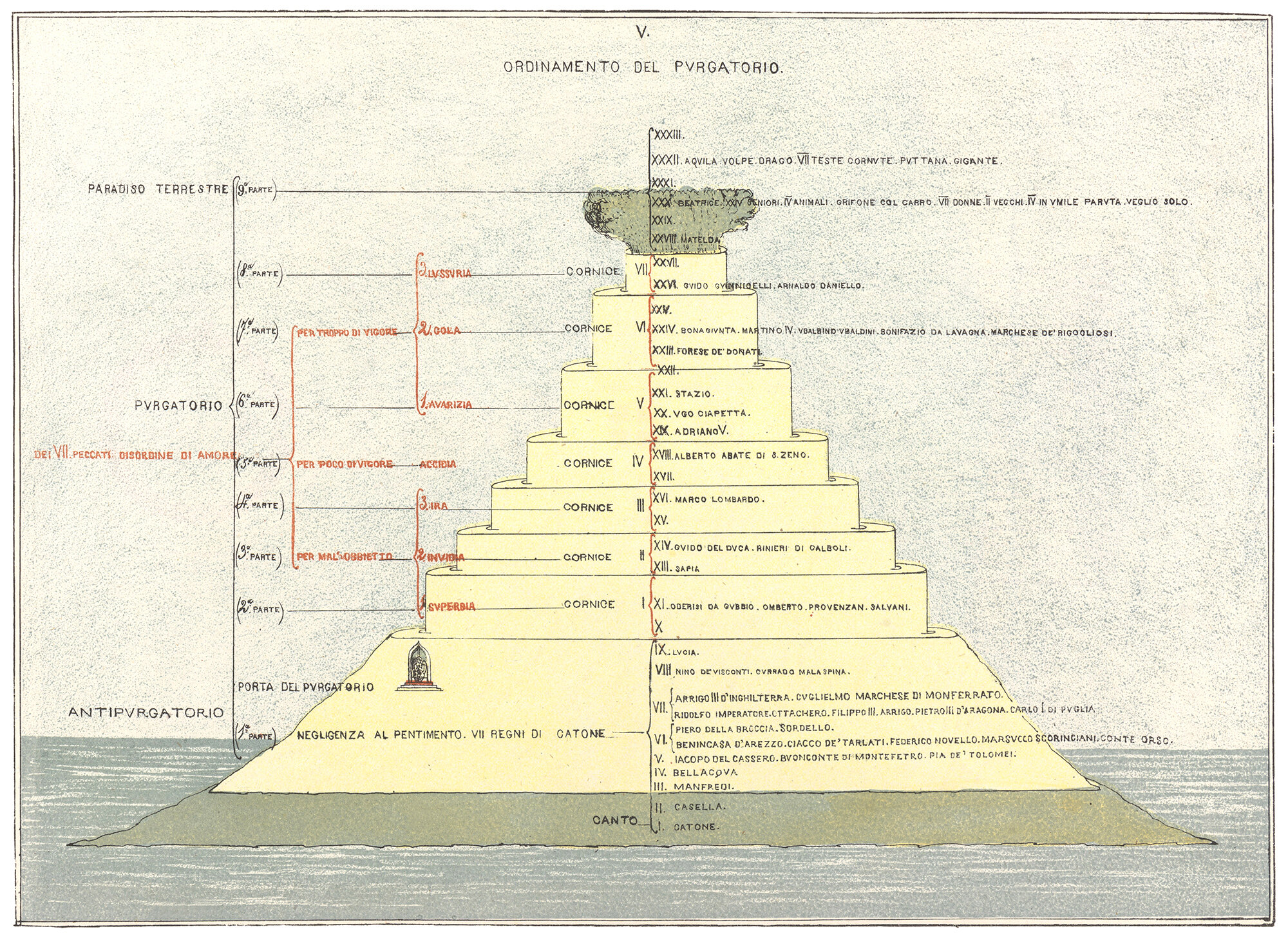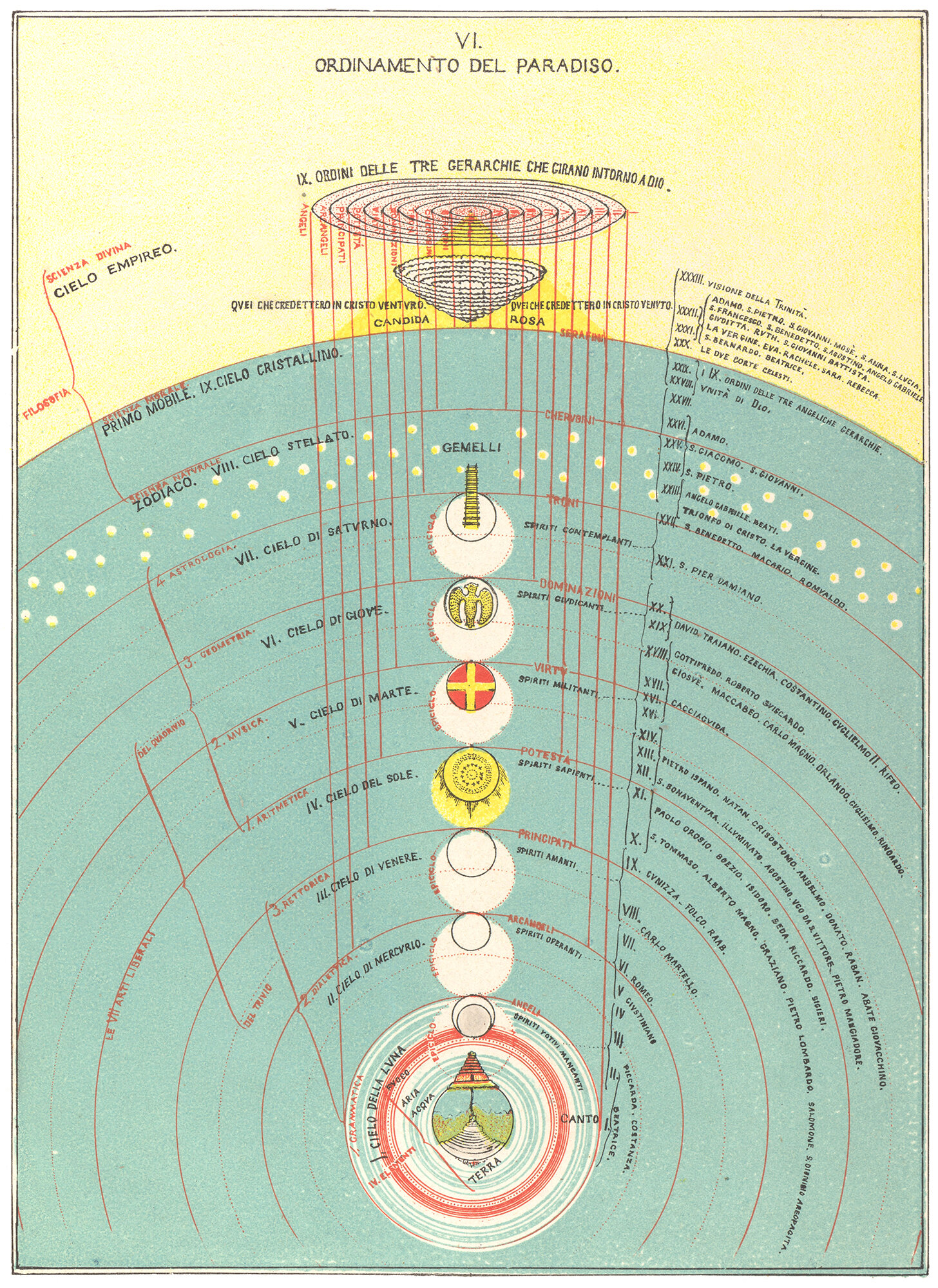Dante’s Divine Comedy and the Vertical Worldview
Dante Alighieri’s epic poem La Divina Commedia, or The Divine Comedy in English, is widely considered one of history’s greatest works of literature. It tells the fictional story of Dante and his soul’s experience after death. The story is divided into three parts: Inferno, representing hell, Purgatorio, representing a type of limbo between heaven and hell, and Paradiso, representing heaven. These three stages correlate to the underground, surface, and sky from the main verticality narrative, respectively. Throughout the story, Dante descends through Inferno, then ascends through Purgatorio and Paradiso. It’s a journey defined by the axis-mundi, and the entire work is rooted in verticality.
Plate from Michelangelo Caetani’s 1855 work La Materia della Divina Commedia di Dante Alighieri, showing a diagram of the universe, including Inferno at the bottom, Purgatorio in the middle, and Paradiso at the top.
Inferno, Purgatorio and Paradiso are all arranged along a single linear axis that runs from the surface of the earth’s northern hemisphere, down through Inferno to the center of the earth, back up to the surface of the southern hemisphere, up Mount Purgatorio, then up through the celestial spheres of Paradiso. This path runs along the axis-mundi, and it’s based on a vertical worldview, with the surface acting as a middle-ground between heaven (the sky) and hell (the underground).
Plate from Michelangelo Caetani’s 1855 work La Materia della Divina Commedia di Dante Alighieri, showing a diagram of Dante’s idea of Inferno.
The poem begins with Dante lost in the forest, unable to find his way and fearful of becoming lost forever. This is an allegory for his soul, which is lost and seeking salvation. He meets Virgil, who acts as his guide, and the two begin their descent into Inferno. Pictured above, Inferno is composed of nine concentric terraces, each one smaller and lower than the previous one. Overall, it resembles an inverted mountain or ziggurat, with its bottom point at the center of the earth. The descent through these terraces is symbolic of Dante traveling away from the surface and further from the sky, as he confronts the three types of sin: the self-indulgent, the violent, and the malicious.
Each terrace, or circle, contains sinners being eternally punished for a different type of sin. As Dante descends down through the circles, the sins, as well as their punishments, get more severe. The bottom of Inferno, at the center of the earth, is where Dante finds Lucifer, or the Devil. It’s fitting that Lucifer is located at the lowest and most central point; all of hell is centered around him and is built up from him, much like the inverse of a mountain’s peak.
After reaching Lucifer, Dante and Virgil escape Inferno by climbing down Lucifer’s body and through the center point of the earth. Once they pass the center, they climb ‘upward’ until they reach the surface of the southern hemisphere, opposite of their starting point. There, they find Mount Purgatorio.
Plate from Michelangelo Caetani’s 1855 work La Materia della Divina Commedia di Dante Alighieri, showing a diagram of Dante’s idea of Purgatorio.
In the second part of the story, Purgatorio, Dante and Virgil emerge on the surface of the southern hemisphere. There they find Mount Purgatorio, which is a terraced mountain that acts as a type of limbo between heaven and hell. This is fitting, since mountains traditionally symbolize a link between heaven and earth. Throughout Purgatorio, Dante and Virgil ascend the mountain, which has nine terraces. The lowest two terraces house Ante-Purgatory, while the next seven represent the seven deadly sins. Above all this is the peak of the mountain, where the characters find the Earthly Paradise.
In Purgatorio, Dante is using verticality as a metaphor for our lives. By ascending through the terraces, the characters must confront the seven deadly sins, and after successfully doing so, they emerge at the top. This is the highest point on the mountain and the closest one can get to heaven on earth. There, Dante meets his muse, Beatrice, who acts as his guide as he ascends into Paradiso.
Plate from Michelangelo Caetani’s 1855 work La Materia della Divina Commedia di Dante Alighieri, showing a diagram of Dante’s idea of Paradiso.
Paradiso represents the sky. After ascending from Mount Purgatorio, Dante then ascends through the nine celestial spheres of heaven. These celestial spheres represent virtues, in contrast to the terraces of Inferno and Purgatorio, which represented sins. Each of the first seven spheres corresponds to a heavenly body, starting with the Moon and continuing with Mercury, Venus, the Sun, Mars, Jupiter and Saturn, respectively. The top two spheres are reserved for the stars and the angels, which represent the highest beings of heaven, furthest from the world of sin below. Above all this, of course, is God.
The Divine Comedy expresses a vertical worldview common to traditional belief systems. Throughout the story, acts of descension and ascension are symbolic of negative and positive acts, respectively. Everything below the surface is sinful and negative; the deeper you go, the worse it gets. Alternately, everything above the surface is virtuous and positive; the higher you go, the better it gets. In short, up equals good and down equals bad. At the ends of this spectrum are the polar opposites of God and Satan, representing good and evil. These are primal concepts, and every traditional belief system has a version of this spectrum, with our lives stuck somewhere in between.
All the elements of verticality play out along Dante’s journey. As humans, we all seek to escape the surface of the earth. In Dante’s worldview, this means we all seek to reach heaven and the Earthly Paradise. He uses mountains, canyons, caves and forests to symbolize the high and low places on earth, and he channels the wonder of the sky into the idea of heaven and eternal salvation. Of course, Dante didn’t invent any of these concepts or places, but he did take great pains to vividly explore the concepts, and he arranged them into a detailed worldview based on verticality. The result is a masterpiece of fiction, which is compelling to read even if you don’t share his beliefs.
Read more about verticality throughout the arts and literature.




